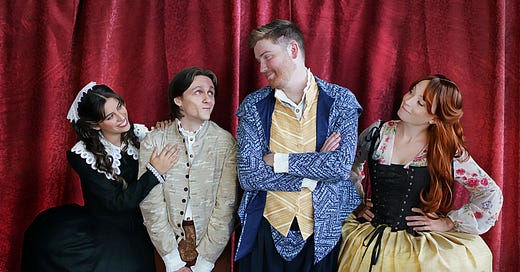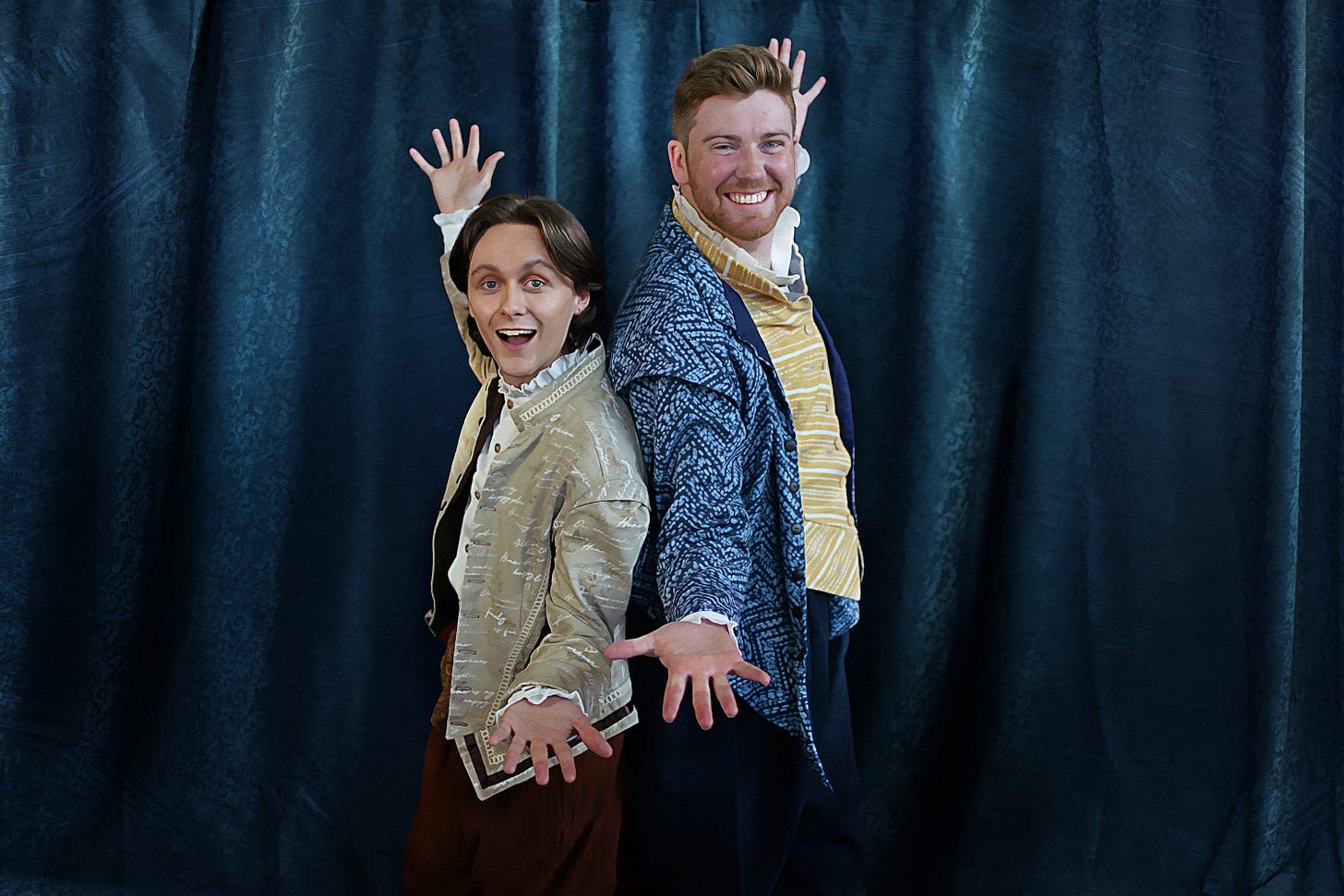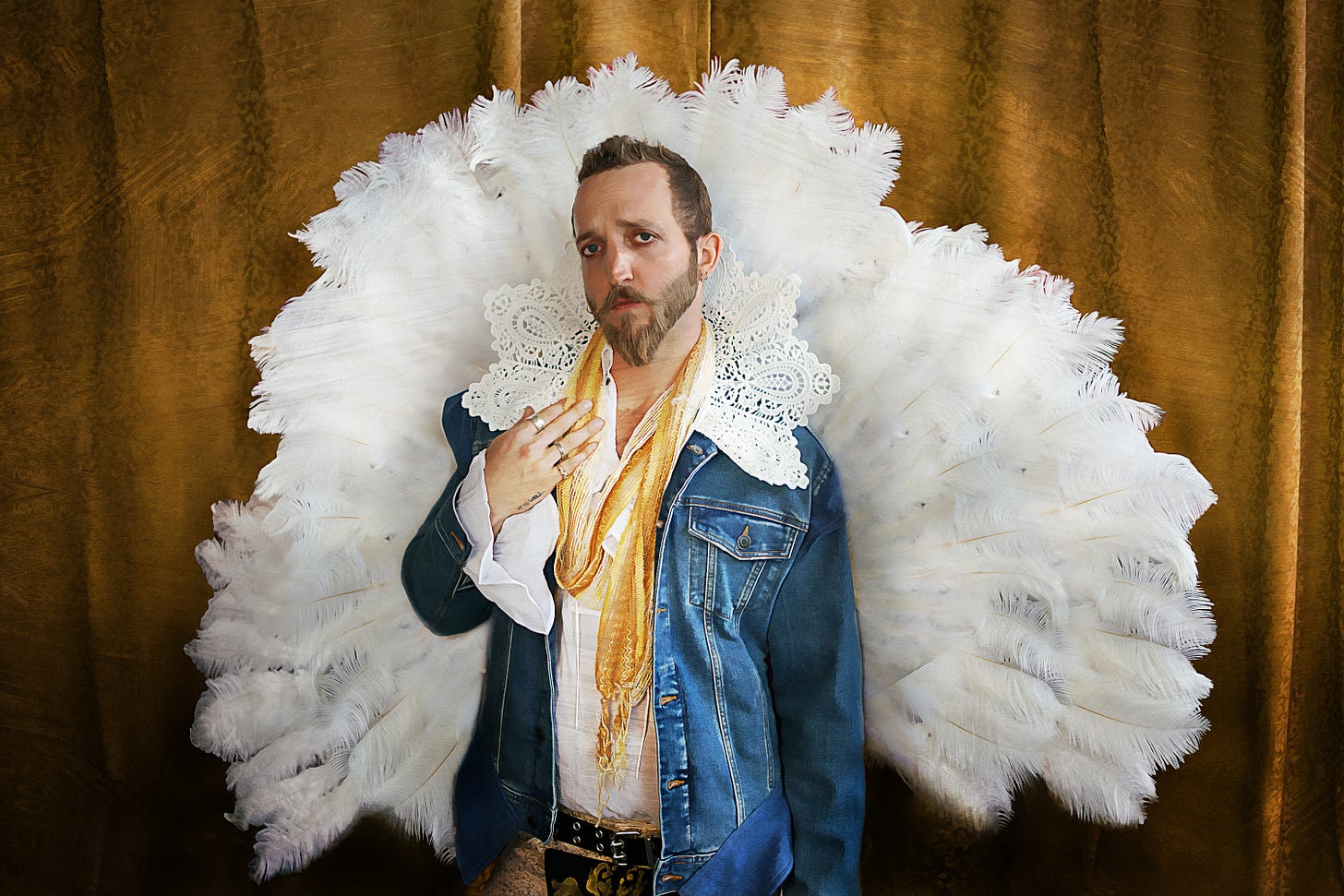Something Rotten Is a Dancers' Show
I visit a rehearsal at Chattanooga Theatre Center to learn about musical theater dance in the best way possible — up close!
Welcome!
You’re reading DanceChatt, a publication for reflective writing about dance in and around Chattanooga. In this issue we visit the Chattanooga Theatre Center, where choreographer Lindsay Fussell tells us about putting together the big, complicated, kick-butt production that is Something Rotten.
You know, I’ve been having conversations with lots of dancers, dance teachers and choreographers over the past few weeks. One thread of discussion is that we tend to self-isolate. I’m not sure whether this is always true, whether it’s more of a grumble than a real thing, or whether it’s just a facet of people’s busy lives. But you know what? It’s something we have the power to change. What if we all commit to watching one program this summer that has nothing to do with our home studio or company?
Let’s give it a try.
Something Rotten Is a Dancers' Show
By Jenn McCormick
Photos by Jeremy Campbell
The Chattanooga Theatre Center will present the musical Something Rotten July 21–Aug. 6. After watching a rehearsal and speaking with some members of the ensemble and the choreographer, Lindsay Fussell, I’m making it a point to come.
Confession time, I’d been sleeping on this one. I keep an eye out for ballet and hip hop and improvisational dance, but less so musical theater shows. By doing so, I now realize, I’ve been missing out on a lot of dance.
I was lucky enough to visit rehearsal last Thursday — one of the last rehearsals before tech week. Because I had read up on the show on the CTC website, I had some idea about the plot, but none whatsoever about the kind of dance to expect. Here’s their synopsis:
Two brothers set out to write the world’s first musical in this hilarious mash-up of 16th century Shakespeare and 21st century Broadway. This outrageous musical farce follows Nick and Nigel Bottom, who are desperate to write a hit play but are stuck in the shadow of that Renaissance rock star known as “The Bard.” When a local soothsayer foretells that the future of theatre involves singing, dancing and acting at the same time, Nick and Nigel set out to write the world’s very first musical.
Reading that, I picture something like the dancing knights in Monty Python and the Holy Grail. Wrong! — so wrong.
Backstage, a bunch of people are engaged in cheerful chatter. I speak with Holli Hutson, a member of the ensemble and one of the dance captains, along with ensemble dancers Emma Witz, Isabelle Miller, and Colette Smith.
“This is one of the hardest working, most talented, fun groups of people to be with,” Holli says. “It’s like being in a summer musical theater camp. The music is fun. Lindsay’s choreography is intricate, challenging, and fun. And we have a variety of ages represented.”
Maybe because I’m sitting on the floor in a wide corridor to get on eye level with the folks stretching out, I see some younger members of the ensemble first. Emma is excited about her first show at CTC. When I ask whether she’s nervous, she beams. “Our choreographer makes the dancing so effortless. I didn’t dance seriously until college, but she makes everyone look good regardless of their skill level.”
Isabelle, from UTC, agrees. “My experience has been wonderful,” she says. “Dance is a newly inspired passion for me.” She explains she’s only been dancing about five years. “I started at CCA, where Lindsay did some choreography. Seeing her process and getting to understand how her brain works has been wonderful.”
Holli nods. “It’s ‘learning to speak Lindsay,’ she says. “You learn when to listen and when to ask questions.”
“What is her choreography like?” I ask.
“True musical theater dance,” Isabelle says. “There are big, show-stopping kicks … but it’s pulled from so many places to create something unique.”
Colette, who attends Chicago College of Performing Arts, is also loving the experience. “I’ve never been in a show with so much nonstop dancing,” she says. “It’s all dancing!”
In fact, Holli explains, she isn’t the only dance captain — she’s just one of three. It takes several people to teach a long show’s worth of choreography to the ensemble and help keep the choreography straight.
“We all help each other out, but our captains are the go-to if someone has questions about the choreography,” she says. “We maintain the choreography throughout the run of the show and pass choreographer’s notes to dancers … For me, different people are stronger, so I delegate different people to demonstrate different steps. There’s a male dance captain who works with the men.”
Between what I’m hearing and the excitement buzzing up and down the corridor, I’m wound up to see this rehearsal — and it does not disappoint.
In the auditorium, a man on stage immediately attracts my attention. In contrast to the young folks in the hallway, this artist gives off wise-old-sage vibes — and he’s warming up with some nimble tap dance steps in his tall, soft boots. I later learn this is Josh Ruben, playing the role of the soothsayer Nostradamus. A teacher at Northwest High School and actor with the Northwest Theatre Co. in Whitfield County, Georgia, Josh only has time to perform with CTC during the summers. And, he teaches dance!
“I do try to get as much dance in our program as I can — even in straight plays,” he says when I speak with him at a break later on. “I direct them very rhythmically. For example, in Romeo and Juliet I choreograph real stage fighting. I teach kids to communicate physically as well as verbally.”
By now I am more than excited. I want to know what kind of dance to expect. “Everything,” is how all the people I talked to so far described Lindsay’s choreographic vocabulary. But what does that mean? I see women in character shoes and men in soft shoes, so that’s a start. And people are wearing street clothes — maybe no balletic or upside-down moves, then? But that leaves a lot of territory.
The director gives some general directions, a man who must be the stage manager gives more directions, the director helps a few actors block out a bit of physical comedy, and we’re off. “Huzzah on Three! One, two, three — huzzah!”
What can I tell you from a rehearsal without giving away too much? First, this really is a dance-heavy show. Almost the whole time the ensemble dancers are on stage, they’re dancing. Even when people aren’t technically dancing, they’re engaging in choreographed movement — for example, one bit of dialogue starts with the protagonists kneeling, then rising to stand on their knees, nose to nose, each word lifting them higher. There are scuffles, slapstick, tableaux. It’s not quite a dance show with words over top — but movement is an equal partner to dialogue.
Second, Holli and her colleagues weren’t wrong about a diversity of styles. I see tap dance, Fosse-esque jazz, hoedown dance, snippets of the Charleston, the twist, and a good old-fashioned high-kicking chorus line. And was that — a bit of a can-can? I know I haven’t noticed everything. There’s rock opera with Will Shakespeare prancing like Freddie Mercury. There’s a Soul Train line. There’s hand jive.
Third, this really is dance for everyone. Certainly, there are dance spaces in town where a wide variety of bodies — large and small, old and young — are represented. But these dancers not only vary from youth to elders, tiny to towering, they all have a different bodily habitus. Some stand erect as ballerinas. Some have an easy loafing stance. They display different training backgrounds, and move like it, yet the choreography is tight and crisp. As soon as they start moving, they’re one tribe. I’m jamming on the unity in diversity, and don’t have the right words to describe it, exactly.
Here it is: the cast and ensemble dancers look like people, people you’d find anywhere — but people who dance and sing as their primary mode of expression. It’s heightened, stylized life … but it’s life.
Fourth and last observation, then: Joy. The joy in the hallway translates to energy and attention in rehearsal and then to exuberant motion on stage. They’re going hard; when I step into the corridor again during the break, everyone’s face is glowing and, perhaps, a tag haggard. In fact, the director sees what I see, though probably with the sharper eyes of familiarity. These folks are giving 110% and have been for a while; they need a break. She gives them the next night off.
At some point in the second half of the rehearsal, choreographer Lindsay Fussell comes in from call-backs for another show. She watches the rest of the run-through beside the director and has notes ready for the ensemble after the rehearsal.
Lindsay teaches dance at CTC and Chattanooga State; she has choreographed numerous musicals for CTC and many others for Chattanooga State, Signal Mountain Playhouse, Chattanooga High School Center for Creative Arts and other venues. I’m a little frightened … after all, I’m about to interview her at past 10 on a busy night. But when she sits down in the audience seat near me she looks tired, yes, but luminous and extraordinarily kind. Her hair is falling in wisps into her eyes. Speaking low so as not to interrupt the other business going on in the theater, she has a soft, joyful voice.
“This is one of the biggest dance-heavy shows we’ve done here in a while,” she says. “There are a lot of moving parts, which makes it very fun but tricky to get all those puzzle pieces to fit together at the proper time. And it takes hours outside of the actual rehearsal. I work from a conductor’s score to see all the little accidental notes.”
She adds that this show is performed to a soundtrack rather than live orchestra, so the dancers know exactly what to expect when.
This show has been a long time coming, she continues.
“I saw it on Broadway with the original Nigel [Bottom, the younger brother],” she says. “I said ‘I’ve got to do this sometime.’”
Then, of course, the pandemic intervened. Now, though, Lindsay is sure the audience will love this show. And why not? I think. It’s big and joyful and just a little bit darkly on-the-nose (imagine a Puritan preaching like a Southern Baptist). And, there are dancing eggs. What’s not to like?
When I ask how many dance numbers the audience can expect, she counts on her fingers. Eight? Nine? She starts again. I try to make notes of her musings but come out with what might be seven and might be eight or nine. A lot of dances, anyhow, a lot, not counting the almost-continuous incidental choreographed movement.
I ask what was most challenging about choreographing and setting this show.
“Sometimes in a community theater it’s a challenge to have your cast present,” she says. “In the summer, people go on vacation … and then there’s the mere magnitude of the numbers. ‘Omelet’ is probably the most challenging. There are so many elements to that number.”
What’s been most rewarding?
“Seeing my work done so beautifully,” she answers immediately. “Monday we did a run-through and I got teared up, the tap number was so together and the dancers were having such a good time.”
She adds that this is definitely a dancers’ show, one professional dancers and teachers will love.
“We have such a variety of concentrations of dance in this community; I think the dance community would enjoy seeing a very funny, well-danced show that leaves you laughing. There are some tender moments and some kick-butt dancing!”
Learn more about Something Rotten
Director: Beth Gumnick
Choreographer: Lindsay Fussell
Musical director: Vincent Hale
When: July 21–Aug. 6.
Where: Chattanooga Theatre Center
To learn more, visit theatrecentre.com.
About the author
Jenn McCormick is a writer, editor and dancer working in Chattanooga. She is the publisher and managing editor of DanceChatt.
Join the Chatt
Join the conversation! If you’re interested in writing for DanceChatt, send a pitch email to jennelisewebster@gmail.com.
You know what we haven’t had yet? Any ekphrastic works. How about dance fiction? Dance poetry? Send your pitches along!
I’m also looking for someone to interview some teachers of dancers of a certain age, and maybe some medical professionals, and write up an article about dancing through middle age. I’ll be on that bad boy like a hot flash on a July night.
Until then, keep dancing.
— Jenn McCormick






